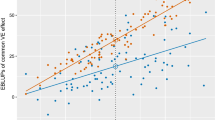Summary
The usefulness of three-mode principal component analysis to explore multi-attribute genotype-environment interaction is investigated. The technique provides a general description of the underlying patterns present in the data in terms of interactions of the three quantities (attributes, genotypes, and environments) involved. As an example, data from an Australian experiment on the breeding of soybean lines are treated in depth.
Similar content being viewed by others
References
Basford, K.E. (1982). The use of multidimensional scaling in analysing multi-attribute genotype response across environments. Australian Journal of Agricultural Research 33, 473–480.
Basford, K.E. & G.J. McLachlan (1985). The mixture method of clustering applied to three-way data. Journal of Classification 2, 109–125.
Byth, D.E. & V.E. Mungomery (1981). Interpretation of plant response and adaptation to agricultural environments. Brisbane: Australian Institute of Agricultural Science (Queensland Branch).
Carroll, J.D. & J.J. Chang (1970). Analysis of individual differences in multidimensional scaling via an N-way generalization of Eckart-Young decomposition. Psychometrika 35, 283–319.
Gabriel, K.R. (1971). The biplot graphical display of matrices with applications to principal components. Biometrika 58, 452–462.
Kapteyn, A., H. Neudecker & T. Wansbeek (1986). An approach to n-mode components analysis. Psychometrika 51, 269–275.
Kroonenberg, P.M. (1983). Three-mode principal component analysis: Theory and applications. Leiden, the Netherlands: DSWO Press.
Kroonenberg, P.M. (1984). Three-mode principal component analysis: Illustrated with an example from attachment theory. In H.G. Law, C.W. Snyder Jr., J.A. Hattie & R.P. McDonald (Eds), Research methods for multimode data analysis pp. 64–103). New York: Praeger.
Kroonenberg, P.M. (1985). Three-mode principal component analysis of semantic differential data: The case of a triple personality. Applied Psychological Measurement 9, 83–94.
Kroonenberg, P.M. & P. Brouwer (1985). User's guide to TUCKALS3 (version 4.0). Technical report, University of Leiden, Department of Education.
Kroonenberg, P.M. & J.De Leeuw (1980). Principal component analysis for three-mode data by means of alternating least squares algorithms. Psychometrika 45, 69–97.
Manning, H.L. (1956). Yield improvement from a selection index technique with cotton. Heredity 10, 303–322.
Mungomery, V.E. (1978). Genetic analyses of environmental interactions and effects of competition in soybeans. Unpublished Ph.D. thesis, Department of Agriculture, University of Queensland.
Mungomery, V.E., R. Shorter & D.E. Byth (1974). Genotype × environment interactions and environmental adaptation. I. Pattern analysis — application to soya bean populations. Australian Journal of Agricultural Research 25, 59–72.
Seber, G.A.F. (1977). Linear regression analysis. New York: Wiley.
Shorter, R. (1972). Influence of genotype and environment on chemical composition of soybean seeds (Glycine max (L.) Merrill). Unpublished M.Agr.Sc. thesis, University of Queensland.
Shorter, R., D.E. Byth & V.E. Mungomery (1977). Genotype × environment interactions and environmental adaptation. II. Assessment of environmental contributions. Australian Journal of Agricultural Research 28, 223–235.
Smith, H.F. (1936). A discriminant function for plant selection. Annals of Eugenics 7, 240–250.
Ten Berge, J.M.F., J.De Leeuw & P.M. Kroonenberg (1987). Some additional results on principal components analysis of three-mode data by means of alternating least squares algorithms. Psychometrika 52, 183–191.
Tucker, L.R. (1966). Some mathematical notes on three-mode factor analysis. Psychometrika 31, 279–311.
Williams, W.T. & L.A. Edye (1974). A new method for the analysis of three-dimensional data matrices in agricultural experimentation. Australian Journal of Agricultural Research 25, 803–812.
Williams, W.T. & W. Stephenson (1973). The analysis of three-dimensional data (sites × species × times) in marine ecology. Journal of Experimental Marine Biology and Ecology 11, 207–227.
Author information
Authors and Affiliations
Rights and permissions
About this article
Cite this article
Kroonenberg, P.M., Basford, K.E. An investigation of multi-attribute genotype response across environments using three-mode principal component analysis. Euphytica 44, 109–123 (1989). https://doi.org/10.1007/BF00022605
Received:
Accepted:
Issue Date:
DOI: https://doi.org/10.1007/BF00022605




